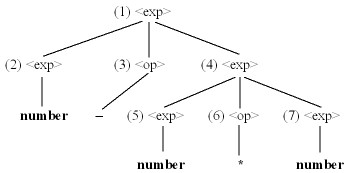Slide 3.2: Ambiguity (cont.)
Home

|
Slide 2.7: Parse trees Slide 3.2: Ambiguity (cont.) Home |

|
<exp> ::= <exp> <op> <exp> | ( <exp> ) | number <op> ::= + | – | *A leftmost derivation of the string “
number–number*number” and its corresponding parse tree are given as follows:
(1) <exp> ⇒ <exp> <op> <exp> (2) ⇒ <exp> <op> <exp> <op> <exp> (3) ⇒ number <op> <exp> <op> <exp> (4) ⇒ number – <exp> <op> <exp> (5) ⇒ number – number <op> <exp> (6) ⇒ number – number * <exp> (7) ⇒ number – number * number |

|
number–number*number” and its corresponding parse tree are given as follows:
(1) <exp> ⇒ <exp> <op> <exp> (2) ⇒ number <op> <exp> (3) ⇒ number – <exp> (4) ⇒ number – <exp> <op> <exp> (5) ⇒ number – number <op> <exp> (6) ⇒ number – number * <exp> (7) ⇒ number – number * number |

|
number–number*number” can be generated by two different parse trees where the latter is correct according to the arithmetic rules.
Since it does not specify precisely the syntactic structure of a program, an ambiguous grammar presents a serious problem for a parser, which is a component of compiler that is responsible for syntactical analysis of a sentence.